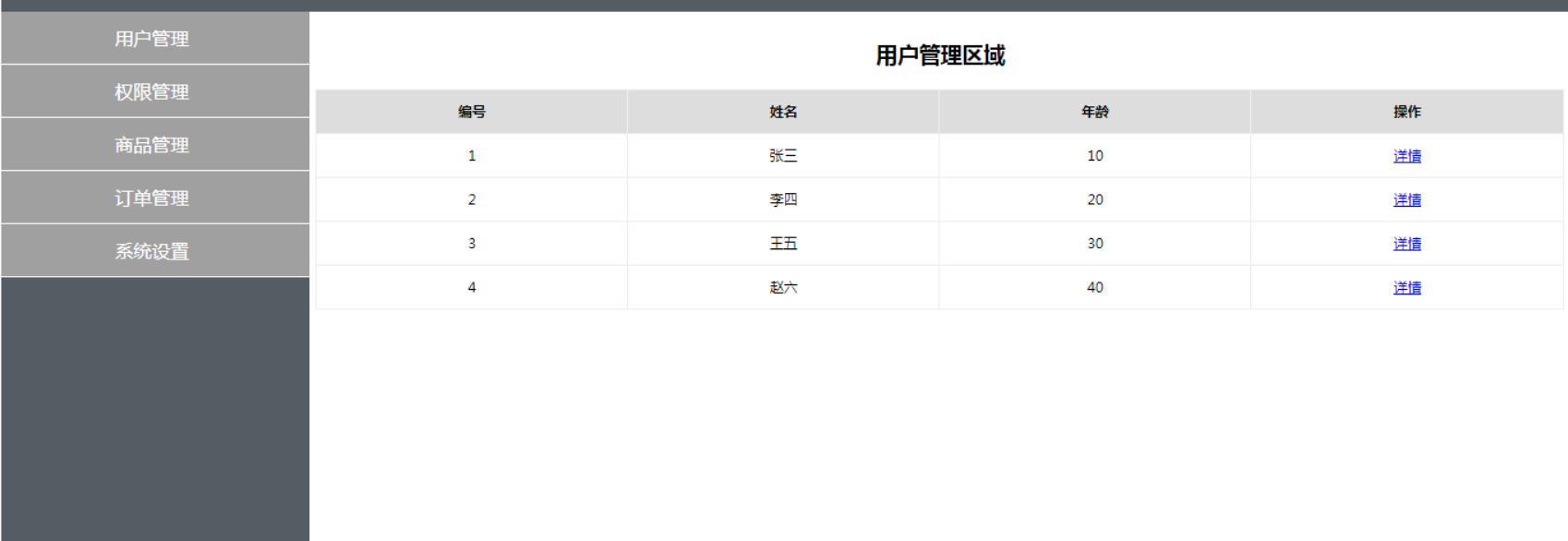# 52.实现后台管理案例(★★★)
案例效果:

点击左侧的"用户管理","权限管理","商品管理","订单管理","系统设置"都会出现对应的组件并展示内容
其中"用户管理"组件展示的效果如上图所示,在用户管理区域中的详情链接也是可以点击的,点击之后将会显示用户详情信息。
用到的路由技术点:
- 路由的基础用法
- 嵌套路由
- 路由重定向
- 路由传参
- 编程式导航
根据项目的整体布局划分为组件结构, 通过路由导航控制组件的显示
1.抽离并渲染 APP 根组件
2.将左侧菜单改造为路由链接
3.创建左侧菜单对应的路由组件
4.在右侧主体区域添加路由占位符
5.添加子路由规则
6.通过路由重定向默认渲染用户组件
7.渲染用户列表数据
8.编程式导航跳转到用户详情页
9.实现后退功能
案例思路: 1).先将素材文件夹中的11.基于vue-router的案例.html复制到我们自己的文件夹中。看一下这个文件中的代码编写了一些什么内容,这个页面已经把后台管理页面的基本布局实现了
2).在页面中引入vue,vue-router
3).创建Vue实例对象,准备开始编写代码实现功能
4).希望是通过组件的形式展示页面的主体内容,而不是写死页面结构,所以我们可以定义一个根组件:
//只需要把原本页面中的html代码设置为组件中的模板内容即可
const app = {
template:`<div>
<!-- 头部区域 -->
<header class="header">传智后台管理系统</header>
<!-- 中间主体区域 -->
<div class="main">
<!-- 左侧菜单栏 -->
<div class="content left">
<ul>
<li>用户管理</li>
<li>权限管理</li>
<li>商品管理</li>
<li>订单管理</li>
<li>系统设置</li>
</ul>
</div>
<!-- 右侧内容区域 -->
<div class="content right">
<div class="main-content">添加用户表单</div>
</div>
</div>
<!-- 尾部区域 -->
<footer class="footer">版权信息</footer>
</div>`
}
2
3
4
5
6
7
8
9
10
11
12
13
14
15
16
17
18
19
20
21
22
23
24
25
26
5).当我们访问页面的时候,默认需要展示刚刚创建的app根组件,我们可以创建一个路由对象来完成这个事情,然后将路由挂载到Vue实例对象中即可
const myRouter = new VueRouter({
routes:[
{path:"/",component:app}
]
})
const vm = new Vue({
el:"#app",
data:{},
methods:{},
router:myRouter
})
2
3
4
5
6
7
8
9
10
11
12
补充:到此为止,基本的js代码都处理完毕了,我们还需要设置一个路由占位符
<body>
<div id="app">
<router-view></router-view>
</div>
</body>
2
3
4
5
6).此时我们打开页面应该就可以得到一个VueRouter路由出来的根组件了 我们需要在这个根组件中继续路由实现其他的功能子组件 先让我们更改根组件中的模板:更改左侧li为子级路由链接,并在右侧内容区域添加子级组件占位符
const app = {
template:`<div>
........
<div class="main">
<!-- 左侧菜单栏 -->
<div class="content left">
<ul>
<!-- 注意:我们把所有li都修改为了路由链接 -->
<li><router-link to="/users">用户管理</router-link></li>
<li><router-link to="/accesses">权限管理</router-link></li>
<li><router-link to="/goods">商品管理</router-link></li>
<li><router-link to="/orders">订单管理</router-link></li>
<li><router-link to="/systems">系统设置</router-link></li>
</ul>
</div>
<!-- 右侧内容区域 -->
<div class="content right">
<div class="main-content">
<!-- 在 -->
<router-view></router-view>
</div>
</div>
</div>
.......
</div>`
}
2
3
4
5
6
7
8
9
10
11
12
13
14
15
16
17
18
19
20
21
22
23
24
25
26
然后,我们要为子级路由创建并设置需要显示的子级组件
//建议创建的组件首字母大写,和其他内容区分
const Users = {template:`<div>
<h3>用户管理</h3>
</div>`}
const Access = {template:`<div>
<h3>权限管理</h3>
</div>`}
const Goods = {template:`<div>
<h3>商品管理</h3>
</div>`}
const Orders = {template:`<div>
<h3>订单管理</h3>
</div>`}
const Systems = {template:`<div>
<h3>系统管理</h3>
</div>`}
//添加子组件的路由规则
const myRouter = new VueRouter({
routes:[
{path:"/",component:app , children:[
{ path:"/users",component:Users },
{ path:"/accesses",component:Access },
{ path:"/goods",component:Goods },
{ path:"/orders",component:Orders },
{ path:"/systems",component:Systems },
]}
]
})
const vm = new Vue({
el:"#app",
data:{},
methods:{},
router:myRouter
})
2
3
4
5
6
7
8
9
10
11
12
13
14
15
16
17
18
19
20
21
22
23
24
25
26
27
28
29
30
31
32
33
34
35
36
7).展示用户信息列表:
A.为Users组件添加私有数据,并在模板中循环展示私有数据
```
const Users = {
data(){
return {
userList:[
{id:1,name:"zs",age:18},
{id:2,name:"ls",age:19},
{id:3,name:"wang",age:20},
{id:4,name:"jack",age:21},
]
}
},
template:`<div>
<h3>用户管理</h3>
<table>
<thead>
<tr>
<th>编号</th>
<th>姓名</th>
<th>年龄</th>
<th>操作</th>
</tr>
</thead>
<tbody>
<tr :key="item.id" v-for="item in userList">
<td>{{item.id}}</td>
<td>{{item.name}}</td>
<td>{{item.age}}</td>
<td><a href="javascript:;">详情</a></td>
</tr>
</tbody>
</table>
</div>`}
```
2
3
4
5
6
7
8
9
10
11
12
13
14
15
16
17
18
19
20
21
22
23
24
25
26
27
28
29
30
31
32
33
34
35
8.当用户列表展示完毕之后,我们可以点击列表中的详情来显示用户详情信息,首先我们需要创建一个组件,用来展示详情信息
const UserInfo = {
props:["id"],
template:`<div>
<h5>用户详情</h5>
<p>查看 {{id}} 号用户信息</p>
<button @click="goBack">返回用户详情页</button>
</div> `,
methods:{
goBack(){
//当用户点击按钮,后退一页
this.$router.go(-1);
}
}
}
2
3
4
5
6
7
8
9
10
11
12
13
14
然后我们需要设置这个组件的路由规则
const myRouter = new VueRouter({
routes:[
{path:"/",component:app , children:[
{ path:"/users",component:Users },
//添加一个/userinfo的路由规则
{ path:"/userinfo/:id",component:UserInfo,props:true},
{ path:"/accesses",component:Access },
{ path:"/goods",component:Goods },
{ path:"/orders",component:Orders },
{ path:"/systems",component:Systems },
]}
]
})
const vm = new Vue({
el:"#app",
data:{},
methods:{},
router:myRouter
})
2
3
4
5
6
7
8
9
10
11
12
13
14
15
16
17
18
19
20
再接着给用户列表中的详情a连接添加事件
const Users = {
data(){
return {
userList:[
{id:1,name:"zs",age:18},
{id:2,name:"ls",age:19},
{id:3,name:"wang",age:20},
{id:4,name:"jack",age:21},
]
}
},
template:`<div>
<h3>用户管理</h3>
<table>
<thead>
<tr>
<th>编号</th>
<th>姓名</th>
<th>年龄</th>
<th>操作</th>
</tr>
</thead>
<tbody>
<tr :key="item.id" v-for="item in userList">
<td>{{item.id}}</td>
<td>{{item.name}}</td>
<td>{{item.age}}</td>
<td><a href="javascript:;" @click="goDetail(item.id)">详情</a></td>
</tr>
</tbody>
</table>
</div>`,
methods:{
goDetail(id){
this.$router.push("/userinfo/"+id);
}
}
}
2
3
4
5
6
7
8
9
10
11
12
13
14
15
16
17
18
19
20
21
22
23
24
25
26
27
28
29
30
31
32
33
34
35
36
37
38
